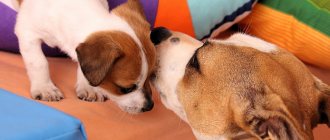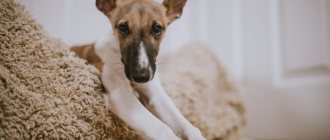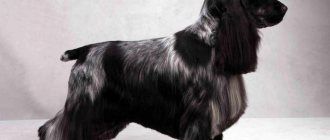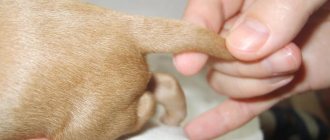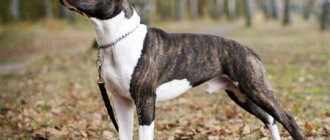- September 23, 2018
- Dogs and hunting with them
- Elena Motrenko
To raise a good hunting dog, it is very important to choose the right puppy. Hunters often opt for the husky. It must be taken into account that the puppy should only come from the best representatives of the Laika breed. This guarantees that the hunter will have the opportunity to get more meat and furs.
One of the signs of a purebred husky is its small, erect, pointed ears. Many dog owners have a question about when a husky puppy's ears stand up. Let's figure it out further.
Story
Laika is one of the oldest dog breeds. Initially, it was bred by residents of the North, including the Tungus. By crossing with other dogs, representatives of the breed deprived their offspring of the valuable qualities inherent in the husky. To preserve the purity of the breed, northern hunters shot all alien dogs without regret.
Intensive breeding of huskies began in the nineteenth century. Then the husky was called the northern pointy-eared dog. At this time, breed standards were clearly described, and the behavioral characteristics of these dogs during hunting were studied. In 1928, for the first time in Russia, an exhibition was organized where various varieties of huskies were presented.
During the war, huskies were used for transporting goods, as well as for blowing up objects and searching for mines, which reduced the number of representatives of this breed. In order to rectify the situation at the end of the war, dog kennels were created, in particular those that exclusively housed huskies. Intensive breeding of these dogs has provoked the need to establish new breed standards.
Today we have many types of husky breeds. They all differ from other dogs in a common set of character traits.
Is it possible to put ears on an adult dog?
You should not try to find information on how to install the ears of an adult dog. After 1 year, all popular methods stop giving results. This is due to the fact that the cartilage tissue no longer changes.
The only possible solution is plastic surgery, but it carries a lot of risks. To achieve the desired shape, you often have to resort to repeated surgery, the consequences of which do not always justify the final result. It is equally important that operated pets are excluded from breeding.
Laika: hunting characteristics
Laika is one of the best hunting dogs. Representatives of this breed took all the best qualities from their ancestors: excellent scent, vision, dexterity and intuition. The hunting instinct of a husky works even if the dog has never been hunting. They are excellent helpers for commercial hunters. Laikas are good in fishing for:
- fur animals;
- large game: bear, elk and others;
- waterfowl.
A dog of this hunting breed informs its owner about the accomplished fact of catching an animal with a loud bark, but during the hunting process itself the husky behaves very quietly so as not to frighten off the prey.
The husky barks at small game in order to stop it, then crushes it and brings it to the owner, unlike most other dogs, which leave the prey in place. The dog does not gnaw or bite the animal - this is important to preserve the integrity of its skin.
The dog informs its owner about the presence of large game with a piercing bark. Depending on the type of hunting object, the husky can change the frequency of its bark and the tone of its voice. Thanks to this, the hunter recognizes which hunting resource the dog has entered. When chasing game, the husky becomes silent.
Dogs of this breed are universal and can hunt any animal, but if desired, they can be trained to catch only one type of hunting resource. Then, when going hunting, the husky will not disperse its attention to unnecessary objects.
Laikas are not only used for hunting, they are also excellent sled dogs. With great pleasure they will give you a ride in a harness.
These dogs are very loyal to their owner, are not picky and get used to any conditions. That is why they are currently not only used for hunting, but also kept in city apartments.
But huskies, as a rule, are independent and freedom-loving; they are difficult to train. The educational process must begin when the dog is at an early age.
How to put ears on a puppy or dog at home
First, make an appointment with your veterinarian for an examination. He will find out the cause of lop ears and explain what to do to make your dog's ears stand up. There are 3 ways to do this: reviewing the diet, massage and gluing.
Review your diet and add vitamins
The lack of calcium is compensated for with food and vitamins. To do this, add the following products to the diet:
- natural cottage cheese;
- goat milk;
- aspic.
Thanks to fermented milk products and gelatin, the cartilage tissue strengthens and begins to lift the ear tissue. Vitamins are added strictly as prescribed by the veterinarian. An incorrectly selected vitamin complex can result in a surplus of other microelements.
Do massage
Massage stimulates blood circulation. Thanks to increased blood flow, the cartilage becomes denser and stretches the ear tissue in the desired direction.
You need to massage every day until you get the desired result. To do this, simply follow the following sequence:
- Take the base of your ear with two fingers and massage it gently.
- Move from bottom to top towards the tip, trying to pull the auricle straight up.
- Repeat the previous steps 5-10 times. Work very carefully and gently so as not to cause discomfort. The pet should enjoy the process and feel relaxed.
If changing your diet and massage do not produce results, do not rush to sign up for surgery. In most cases, the problem is solved by gluing.
Perform gluing
Fixation with gluing is carried out in 2 ways: using a soft and rigid structure. The first option is used for undocked dogs, and the second for docked dogs.
Indications and contraindications
Adhesive bonding is recommended if there is no effect from other methods of installing the ear canopy. It is effective in almost all cases, regardless of the size of the animal and the presence of docking.
This procedure has no contraindications and is completely safe from a physiological point of view. But it is important to note that the dog may try to rip the unusual structure off its head. For this purpose, particularly violent animals are given an Elizabethan collar.
Soft design
The soft design is used for small undocked dogs. It is constructed from a wide adhesive plaster and fabric adhesive tape, guided by the following algorithm:
- Use a trimmer to remove hairs from both sides of each ear pad to reduce their weight and make it easier to remove the patch later.
- Wipe bare skin with rubbing alcohol. He will degrease the ears for subsequent fixation of the patch.
- Gently pull the tips of the ears up and bend them back a little to straighten the cartilage at the base.
- Roll both sheets into a tube towards the center of the skull, maintaining their vertical position, and wrap with adhesive tape. Move from bottom to top, avoiding blocking the ear canal.
- Make sure that the cartilage at the base of the ear is not bent. Straighten it back if necessary.
- Connect the resulting “horns” together with adhesive tape, winding it horizontally.
The resulting design is worn for no more than 5-6 days. If the installation was not successful on the first try, the gluing is repeated after 1-2 days. The final withdrawal is carried out after obtaining the desired result.
Rigid design
The rigid frame is suitable for docked dogs and large breeds. The scheme for its creation is similar to the soft one. The only difference is the required materials. In addition to the patch, to set up your dog’s ears you will need:
- spatula for applying medical glue;
- ice cream sticks for fixing the desired position of the ears from the inside;
- foam rollers glued with glue to fix the ears from the outside;
- construction tape to secure the final structure at its base.
The rigid frame is installed strictly after tightening the surgical sutures. Please note that the appearance of a slight allergy after removing the patch is not a contraindication. The reaction goes away on its own within 1-2 days.
Description of the breed
In appearance, the husky is often confused with a husky.
The Laika breed is closest to the wolf type and has the same body structure. In addition to its appearance, the husky also retained a pronounced wolf hunting instinct.
All varieties of huskies have common features:
- the head is wedge-shaped;
- sharp, erect ears (we’ll find out later when a husky puppy’s ears stand up);
- the tail is curled in the shape of a ring;
- short-haired dog with thick undercoat;
- on the neck there is voluminous fur in the form of a collar;
- strong body;
- powerful muscles;
- beautiful posture.
The coat color can vary from white to black.
What to do if your ears don't stand up?
If your German Shepherd is six months old and his shells are hanging, consult a veterinarian or an experienced dog trainer. Diet correction is necessary, however, physiotherapeutic actions will also be required. Clean your ears regularly, get all the necessary vaccinations, and get rid of worms quarterly. See the article on how often to worm puppies.
Give your pet toys to chew on. This is how the jaw muscles and the adjacent muscles of the auricle develop. Carry out diagnostics. Feel the ear, find a relaxed place in it. It has the shape of a spot and, if located in the upper part, the prognosis is favorable. Give your pet a light massage to activate local blood circulation and wait for the ear to heal on its own.
If the weak point is located at the bottom of the sink, you will have to build a structure to support the sink.
Watch the video:
We will consider the process of ear installation in more detail in the next section.
Causes of the problem
When a husky puppy’s ears stand up, the following factors may interfere with the process:
- Heredity (when purchasing a puppy, you need to familiarize yourself with its pedigree, find out whether the dog’s ancestors had ear problems).
- The animal’s well-being (weakened immunity can cause the ears to fall off).
- Diet (the puppy’s diet should contain enough vitamins and microelements for its proper development).
- The degree of activity of the pet (insufficient activity negatively affects the development of bones and cartilage, excessive activity causes overwork, which also has a bad effect on appearance).
- Vaccinations can also negatively affect the condition of a dog's ears.
- Stress.
During the period when the husky's ears stand up, the replacement of milk teeth with molars may begin. At this time, even erect ears can fall and remain in a hanging position for up to six months.
So, what time a husky’s ears stand up depends on various reasons. By eliminating the obstacles that have arisen, you can speed up this process.
At what age should ears stand up?
Natural setting occurs due to the compaction of the cartilage. The recommended age varies between 2-5 months and depends on the breed.
Standards for different breeds
Representatives of small breeds are famous for faster growth. Yorkshire terriers require only 2-3 months to train. For German Shepherds this takes 4-5 months.
Large and giant dogs, whose average weight is 26-50 kg or more, have to wait the longest. This group includes Caucasian Shepherd Dogs, Alabais and Great Danes. Their owners should be patient, as the approximate waiting time is 6-8 months.
When to start worrying
You need to puzzle over how to put ears on a puppy after 7-8 months. Most often, shape is achieved through surgery, but there are also safe methods used in the early stages.
Sometimes help may be needed when creases appear, there is no change at all, or there is a prolonged loss of progress when changing teeth or after the first vaccination. In these situations, you should contact your veterinarian.
Emergency measures
Sometimes it happens that all measures are taken, but there is no result. When a husky puppy’s ears do not stand up and all of the above actions are useless, you should move on to extreme measures.
Such measures include gluing. Algorithm of actions:
- Clean your ears with alcohol.
- Trim or shave the fur on the ears.
- Roll the ear cartilage into a tube.
- Seal with a plaster (it is better to use a hypoallergenic one to avoid skin irritation).
- Connect both ears with a bandage.
- After two weeks, remove the structure.
If everything was done correctly, but the ears fell again, after a two-day break you should repeat everything in the same order. It is recommended to carry out the procedure until a stable result is obtained.
You can purchase special inserts at the pharmacy to put your ears in the desired position.
Why doesn't the puppy have ears?
Among the possible causes, there are only 3. They are associated with poor nutrition, injuries and the individual characteristics of the pet.
Lack of vitamins
Ear cartilage needs a lot of calcium. When there is a shortage of it, the body directs its main reserves to more important structures: joints, teeth and bones.
Cartilage problems
The baby can damage the ear linen during games or fights. It can also be accidentally pinched by the owner who did not notice the puppy hiding behind the door. If the injury is serious, surgery will be required to repair the cartilage.
Another possible reason is the meatiness of the canvas itself. Additional support is required for proper placement. It is achieved by gluing.
Genetic predisposition or marriage, crossbreeding
Pets born from parents with weakened ears often suffer from a similar problem. Despite the complexity, lop ears in this case are completely solvable.
The erect ears will have to be abandoned only if the marriage caused by cross-breeding is confirmed. For this reason, you should not buy animals secondhand. An unscrupulous seller may sell you a puppy from a lop-eared dog. In such a situation, all methods are ineffective.
How to carry out the installation procedure correctly
The procedure for placing shells depends on the breed of the pet. The basic rules for how to glue them and secure them are the same. But each breed has its own nuances.
Chinese Crested
The peculiarity of this breed is that it has very long and fluffy hair. Before gluing the shells on representatives of this breed, you need to carefully cut off all the hair. Thanks to this, you can achieve tight contact of the patch with the skin and reduce discomfort when removing it.
Many owners worry that the ears will not become covered with hair again. But this is a misconception. Once they are fully erect, the fur will grow back.
Yorkshire Terrier
In order to put a shell on your Yorkshire Terrier, you can use simple textile glue. Since the ears of this breed are very light. You need to cut off the glue regularly to give the skin a rest, then apply it again.
Yorkshire Terrier - the owner of soft cartilage
German Shepherd
Most often, German Shepherds' ears stand up on their own, since the cartilage is very strong. But sometimes problems arise due to improper development.
If difficulties arise, you can find out what to give your puppy to make his ears stand up. Shepherd dogs are recommended foods fortified with calcium. A good effect can be achieved by massaging the shells.
Dobermans
For this breed, erect ears are very important. Pets are given them within a day after docking. The suture that remains after surgery can stretch the cartilage, deforming it. So he begins to fall and never gets up again. Most often, Dobermans use a wire crown, which is attached to their ears.
What are the types of erect ears?
Each puppy is born with tiny, neat ears gathered on top of its head. As the puppy grows, the ears straighten and rise if the pet's food contains enough nutrients and calcium.
The rising ears can take different positions:
- “helicopter”: ears hang in opposite directions;
- “house”: bend towards the middle and converge in a triangle above the top of the head;
- different positions: it happens that a puppy holds his ears completely differently - for example, one bends towards the top of the head, and the other stands vertically;
- vertical: the most favorable position is when the ears stick out with their tips up.
All of these ear positions are considered normal in growing puppies. In the future, the ears will finally form and rise in the right direction.
As your puppy grows, his head gets larger, and so does the space between his ears. At about 4 months, a puppy's ears already reach the size of a large dog's ears and seem too massive for a child's head.
Different ear positions in dogs. 1 - helicopter, 2 - house, 3 - in one direction, 4 - drooping ears
If at this time the cartilaginous tissue in the auricle is sufficiently dense, then the ears rise without any particular difficulty. Gradually, the angles of inclination in the “house” and “helicopter” positions will decrease, the sharp part will begin to rise, and the ears will straighten until they reach the end point.
Cartilage that is too flexible may not be able to cope with the weight of massive ears. In this case, the sharp half of the ear, instead of straightening out, will bend more and more from the very base.
Adult dog with drooping ear tips
What should the owner pay attention to?
Forming the position of the auricle is the most important process in raising the ears, so the owner needs to carefully monitor how this happens. Nuances to pay attention to:
- The bending lines of the tilted ear should be smooth and resemble an arc, and the tilt should decrease by several millimeters every day. An ear bent to the side or towards the top of the head at an acute angle indicates a crease. The pet needs prompt help in the form of gluing and an auxiliary course of vitamins.
- If ear development has reached the “house” position, be extremely vigilant. This is a standard method of lifting, but if the ears remain in this state for too long, the problem needs to be corrected. There is a risk of developing a difficult-to-remove crease at the beginning of the ear. If the dog is not helped in time, the ears may remain curled towards the top of the head for the rest of his life.
Puppy with house ears
- Even at the final stage there are unpleasant surprises. For example, the ears were almost up, but the owner noticed a small fold on the shell of the ear. If it is not eliminated in time, a scar or crease will form in this place. Urgent gluing is necessary so as not to miss the moment.
- If the auricle has already fully expanded, but has fallen off after changing teeth or for some other reason, you need to wait. Ears that do not straighten again after 10-14 days need to be given additional support. Some experts even believe that it is necessary to feed your pet vitamins and glue the ears immediately after they fall off.
- A lot of ear problems originate from too soft cartilage. In some cases, the ear rises, but does not look strong and sways when walking. The tip of the ear may sway or bend. The gluing will not be able to correct loose cartilage: in this case, calcium and vitamins are needed.
A crease in a dog's ear
How to avoid incorrect development?
It is recommended for a German Shepherd to massage the ears at home. This procedure stimulates blood circulation. It is also imperative to properly prepare a diet for such a dog. Her food should be varied. It must contain the necessary vitamins and minerals.
It is also advisable to stroke the animal’s head as little as possible, otherwise a scar may form along the length of the entire ear and closely monitor its health. If necessary, take him to a veterinarian and consult with him.
Ways to set ears
You can install the ears yourself in natural conditions at home in several ways. The most popular are tube ears, folding and cotton swab.
Tube ears
This is a simple method of installing your puppy's ears and does not require the use of special devices. The owner will need nail scissors, adhesive tape, razor or trimmer. Yorkie is being bathed. Then, the dog’s long hairs are cut off from the outside of the shells with scissors, and the short ones are shaved off with a machine or trimmer. A third of the length should be trimmed.
This is interesting: How often to feed your Yorkie?
Yorkie shells are rolled up into a tube and glued with adhesive tape. If everything is done correctly, the ears become similar to the horns of a cochlea with small gaps in the area of the ear canal. They must stand clearly vertically. The shells are fixed over the patch with a sterile bandage. The bandage should be changed once every three days.
There is a second version of the procedure: two identical squares are cut out of a transparent plaster (its side should be equal to the length of the Yorkie’s ear). Connect the pieces of plaster together, cut off the corners to make an oval. Glue Yorkie tabs to the inside of the sink. The stickers should be changed every day, as the dog will tear them off.
Addition
The method is similar to the first, but causes less discomfort for the Yorkie. Since rolling the shells into a tube can be painful. When folding, the fur is shaved using the same algorithm. Leaving a small space, the ears are folded across, and not along, as in the first option, placing them vertically.
Cotton swab
To glue sinks using this method, you will need a fabric-based bactericidal patch (paper will not work). The fur is removed from the inside with a trimmer or razor. A “petal” is cut out of the patch along the length of the ear. They stick it on. The tips are removed from the cotton swab, placed in the middle of the inside of the sink and secured with a second “petal” of adhesive tape. This is the most humane way to put ears on a Yorkie puppy. It will not cause any discomfort to your pet and is easy to perform.
Glue the shells for no more than a week. After the fixation is removed, positive changes in the shape of the Yorkshire Terrier's ears become noticeable. Sometimes an allergic rash occurs at the site of the sticker. To avoid this, you should use a bactericidal patch on a fabric or silk basis. Before removing the fixation, moisten it with vegetable oil and leave for 3-5 minutes. Remove the structure in one sharp movement. At the end of the procedure, treat your pet with something tasty.
Expert opinion
Anna Abramenko
An avid dog lover. Experience in veterinary medicine since 2009.
Ask a Question
Regardless of the correction method chosen, after removing the fixation, you should regularly remove hair from the ears, massage and include vitamin and mineral supplements in the dog’s diet.
Home methods for gluing ears work in 99 cases out of 100. If it was not possible to place the shells correctly, the reason lies in their large weight or pathologically weak cartilage. In such a situation, only plastic surgery can cope with the problem. But before the operation, its feasibility should be assessed. Because appearance is needed by the owner, not the pet. And after surgery, the Yorkshire Terrier will not be able to officially participate in exhibitions or breeding. Since fallen ears are transmitted genetically.
Advice from breeders and dog owners
Marina “Well, Betty and I suffered a lot! We were told to cut first, then glue. It’s easier to get the dog’s hair cut completely, and at the same time the ears will be trimmed. And after that you can glue it.”
Natalya “I know one breeder, she bought a male dog from one of the nurseries for breeding and exhibitions. By six months his ears were no longer erect. This is how we went to exhibitions: two hours before the event we glued our ears with adhesive tape. They stood for a couple of hours, then returned to a hanging position. Maybe they teased me with something else, I don’t know for sure. It's a complete torment for the dog. My opinion is this: before getting a Yorkie, read the literature and ask other breeders. The puppy was definitely cheap, but that’s another topic…”
Does a terrier need ears?
The breed standard states: the ear must stand up. If the ear does not improve on its own, then you either leave everything as is or take action.
Tell me, does this terrier need ears if you don’t plan to take your pet to shows, but just want a cheerful, cheerful, ringing four-legged friend in your home? We think not.
If you want your pet to take prizes at all dog shows, then:
- Monitor the puppy carefully from the moment it arrives in your home.
- Before the puppy reaches six months of age, carry out the staging procedure.
- If the placement of the “locators” is incorrect, make adjustments.
Why should they be installed?
It is necessary to put ears on dogs so that the pet does not raise doubts about its elite status. Erect ears give animals a more aesthetic and impressive appearance. This issue is especially important for exhibition animals.
Some dog owners do not consider ear studs necessary. Moreover, the standard of many breeds allows them both standing and hanging positions. In any case, the choice remains with the person, and the dog is completely indifferent to what ears it has, because this will not affect its devotion and love.
How to help your dog's ears stand up?
So, when your pet’s ears do not stand up before a certain period, the owner must act. You can install ears for your puppy using the following recommendations from experts:
- Strengthen the puppy's diet. Sufficient amounts of calcium should be present in his diet every day. These are cottage cheese and milk as its rich sources. Jellied meat in the form of boiled pig ears will replenish your dog's gelatin deficiency. You can simply buy ready-made vitamin and mineral complexes at a veterinary pharmacy to eliminate the problem of calcium deficiency. The veterinarian will tell you what kind of drug it should be.
- Massage. It is advisable to place the dog's ears four to five times a day and do a light massage up and down with your fingertips.
- Long walks, sufficient physical activity as a way to strengthen the immune system.
- Special devices. If the previous recommendations were not successful, then you can glue the puppy’s ears. To do this, they are first treated with alcohol for the purpose of degreasing and disinfection. The hair in the middle of the ear is cut, then each of them is carefully rolled vertically into a tube and glued with adhesive tape. This method is recommended for Yorkies. As for German shepherds, there are special inserts and stickers for them. It is usually recommended that dogs wear such artificial aids for at least two weeks. Then there is a break for two days. The procedure is done a second time. It may be necessary to conduct it a third time.
If you are concerned about such problems, then, first of all, you should consult with the owner of the nursery where the dog was purchased, and then with a veterinarian.
Regular massage
The massage is designed to strengthen cartilage and muscle fibers. With regular stimulation of the ears, blood in this area begins to circulate more actively, delivering minerals and nutrients to the tissues.
The procedure must be carried out with great care. If applied incorrectly, the likelihood of ear damage increases.
The procedure is performed as follows:
- The index finger is carefully placed into the auricle at a shallow depth.
- The thumb is placed on the outside of the ear.
- Stimulation is carried out in a circular motion with a smooth stretching of the ears in the direction from the base to the end.
Important! It is better to entrust the first session to an experienced specialist.
2-3 sessions are required per day. Then the effectiveness of the procedure will increase. But you need to know that massage does not provide a 100% guarantee of straightening cartilage.

